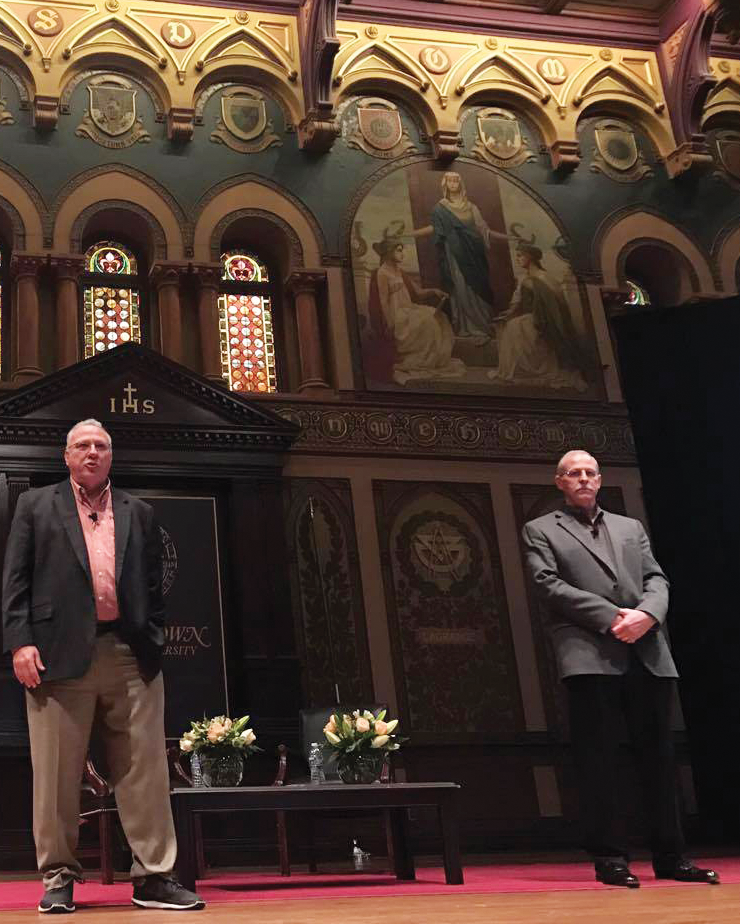
Former DEA agents Javier PeÑa, left, and Steve Murphy, spoke Friday as part of a conference on drug trafficking in Latin America.
Colombian drug lord Pablo Escobar manipulated the Colombian people as he made billions of dollars from the cocaine trade, according to a Feb. 10 talk featuring Javier Peña and Steve Murphy, the two Drug Enforcement Administration agents featured in the Netflix series “Narcos” for their role in capturing Escobar.
The two retired officers featured as keynote speakers for the Drug Trafficking in Latin America: A Case Study on Colombia and Mexico conference in Gaston Hall, organized by the Latin American Student Association, Georgetown University Mexican Student Association and Por Colombia, which advocates solutions to create a stronger Colombia.
Peña sought to eliminate the myth that Escobar was driven to help the poor in Colombian society. According to Peña, Escobar manipulated the Colombian people.
“He was considered a Robin Hood in Medellín. He gave a lot of money to the poor and donated money to churches and hospitals,” Peña said. “But, Pablo was a manipulator, he used all these tactics and campaigns to provide a positive image. Pablo Escobar is the inventor of ‘narco-terrorism.’ He is responsible for the deaths of 10 to 15,000 innocent people.”
Peña said Escobar’s ability to manipulate local Colombians allowed him to maintain power.
“Pablo had great leadership skills. He would get 300 to 500 young kids from the poorest neighborhoods in Colombia and give them money and affection. In turn, these kids would all kill for Pablo,” Peña said.
Escobar not only had a significant impact on Medellín, but also on the international drug trade, according to Peña.
“One kilo of cocaine was $1,000 in the mid-’80sand to transport it was about $5,000,” Peña said. “That kilo of cocaine in Miami in those days was going for about $80,000; in Europe it was going for $100,000 and these guys were selling 2,500 kilos of cocaine on a daily basis. Money was coming into Colombia by the millions of dollars on a daily basis.”
Escobar was ranked as the seventh-richest man in the world, with an estimated wealth of anywhere from $8 to $30 billion. Murphy further exemplified Escobar’s wealth and the methods he took to reach such a level.
“How was this possible? Through capitalizing on the desperation of other people,” Murphy said.
Exclusive pictures and videos of their time in Colombia accompanied the presentation by the two retired DEA agents, including how cocaine used to be smuggled through borders.
“They would take grapefruits, scoop the pulp out, place balls of powder cocaine back in, glue the grapefruit back together and put it back in the sack, and it would work,” Murphy said. “There is only one thing that limits you when you are smuggling drugs and that is your imagination.”
Murphy and Peña concluded their talk with a video showing the day Escobar was caught and killed by Colombian national police in Medellín, Colombia on Dec. 2, 1993.
According to Murphy, “Narcos” failed to accurately portray Escobar’s capture.
“We’re not the real heroes of this story,” Murphy said. “I wasn’t there regardless of what you see in “Narcos.” That was a straight up Colombian national police operation, nobody else. They are the true heroes of that operation that day.”




















